PONTIAC BONNEVILLE 2003 User Guide
Manufacturer: PONTIAC, Model Year: 2003, Model line: BONNEVILLE, Model: PONTIAC BONNEVILLE 2003Pages: 418, PDF Size: 20.24 MB
Page 11 of 418
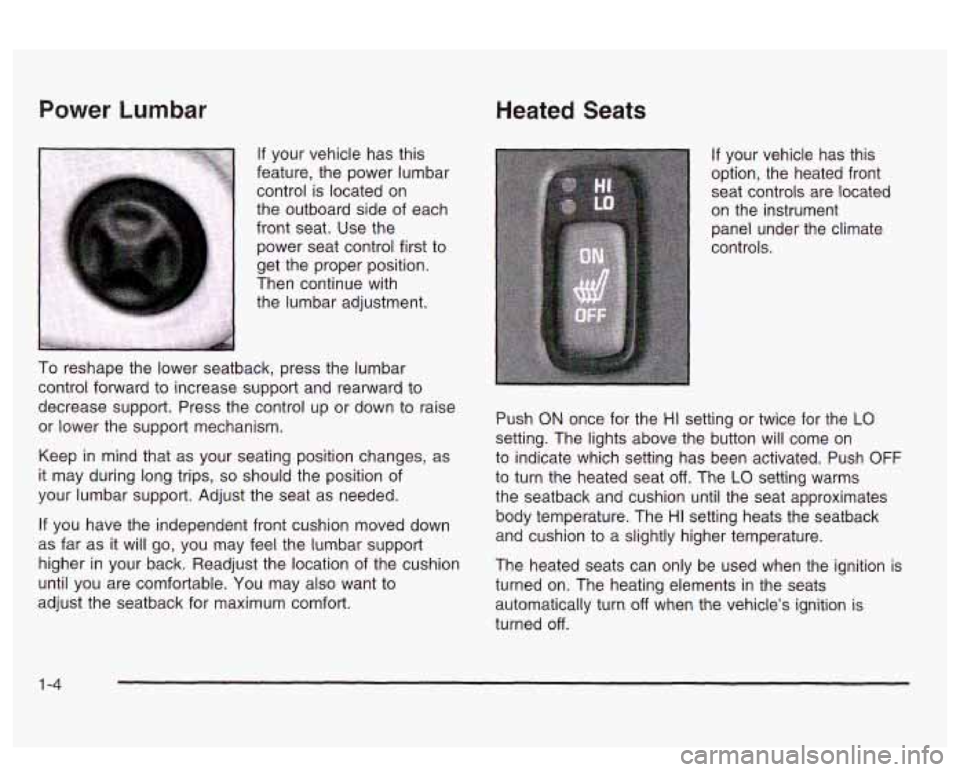
Power Lumbar
If your vehicle has this
feature, the power lumbar
control is located on
the outboard side of each
front seat.
Use the
power seat control first to
get the proper position.
Then continue with the lumbar adjustment.
To reshape the lower seatback, press the lumbar
control forward to increase support and rearward to
decrease support. Press the control up or down to raise
or lower the support mechanism.
Keep in mind that as your seating position changes, as
it may during long trips,
so should the position of
your lumbar support. Adjust the seat as needed.
If you have the independent front cushion moved down
as
far as it will go, you may feel the lumbar support
higher in your back. Readjust the location of the cushion
until you are comfortable. You may also want to
adjust the seatback for maximum comfort.
Heated Seats
If your vehicle has this
option, the heated front
seat controls are located
on the instrument panel under the climate
controls.
Push
ON once for the HI setting or twice for the LO
setting. The lights above the button will come on
to indicate which setting has been activated. Push
OFF
to turn the heated seat off. The LO setting warms
the seatback and cushion until the seat approximates
body temperature. The
HI setting heats the seatback
and cushion to a slightly higher temperature.
The heated seats can only be used when the ignition is
turned on. The heating elements in the seats
automatically turn
off when the vehicle’s ignition is
turned
off.
1 -4
Page 12 of 418
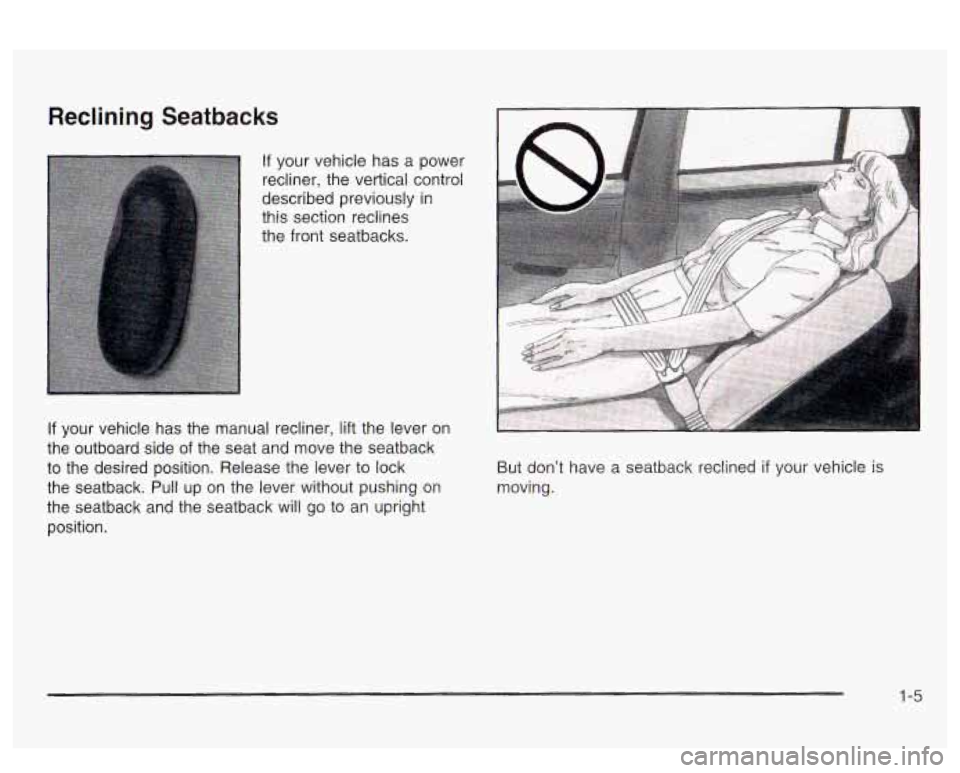
Reclining Seatbacks
If your vehicle has a power
recliner, the vertical control
described previously in
this section reclines
the front seatbacks.
If your vehicle has the manual recliner, lift the lever on
the outboard side
of the seat and move the seatback
to the desired position. Release the lever to lock
the seatback. Pull up on the lever without pushing on
the seatback and the seatback will go to an upright
position. But don’t
have a seatback reclined
if your vehicle is
moving.
1 -5
Page 13 of 418
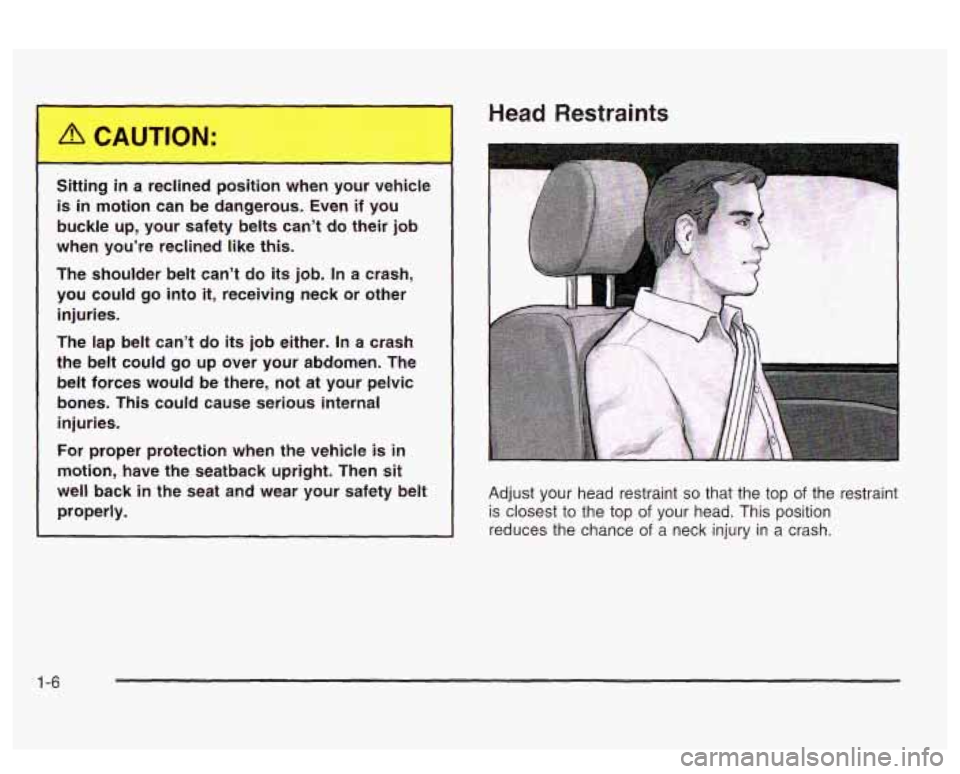
Head Restraints
Sitting in a reclined position when your vehicle
is in motion can be dangerous. Even if you
buckle
up, your safety belts can’t do their job
when you’re reclined like this.
The shoulder belt can’t do its job. In a crash,
you could
go into it, receiving neck or other
injuries.
The lap belt can’t do its job either.
In a crash
the belt could go
up over your abdomen. The
belt forces would be there, not at your pelvic
bones. This could cause serious internal injuries.
For proper protection when the vehicle
is in
motion, have the seatback upright. Then sit
well back
in the seat and wear your safety belt
properly. Adjust your
head restraint so that the top of the restraint
is closest to the top
of your head. This position
reduces the chance
of a neck injury in a crash.
1-6
Page 14 of 418
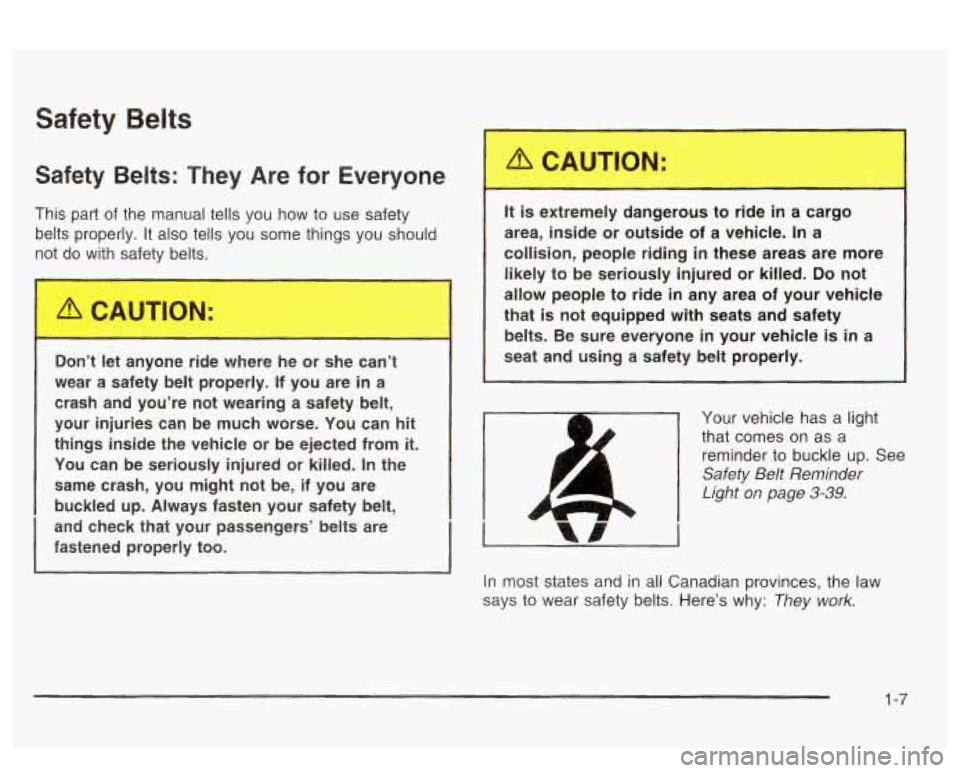
Safety Belts
Safety Belts: They Are for Everyone
This part of the manual tells you how to use safety
belts properly. It also tells you some things you should
not do with safe’.
. belts.
Don’t let anyone ride where he or she can’t
wear a safety belt properly. If you are
in a
crash and you’re not wearing a safety belt,
your injuries can be much worse. You can
hit
things inside the vehicle or be ejected from it.
You can be seriously injured or killed. In the
same crash, you might not be, if you are
buckled
up. Always fasten your safety belt,
and check that your passengers’ belts are
fastened properly too.
It is extremely dangerous to ride in a cargo
area, inside or outside of a vehicle.
In a
collision, people riding
in these areas are more
likely to be seriously injured or killed.
Do not
allow people to ride
in any area of your vehicle
that
is not equipped with seats and safety
belts. Be sure everyone
in your vehicle is in a
seat and using a safety belt properly.
Your vehicle has a light
that comes on as a
reminder to buckle up. See
Safety Belt Reminder
Light
on page 3-39.
In most states and in all Canadian provinces, the law
says to wear safety belts. Here’s why:
They work.
1-7
Page 15 of 418
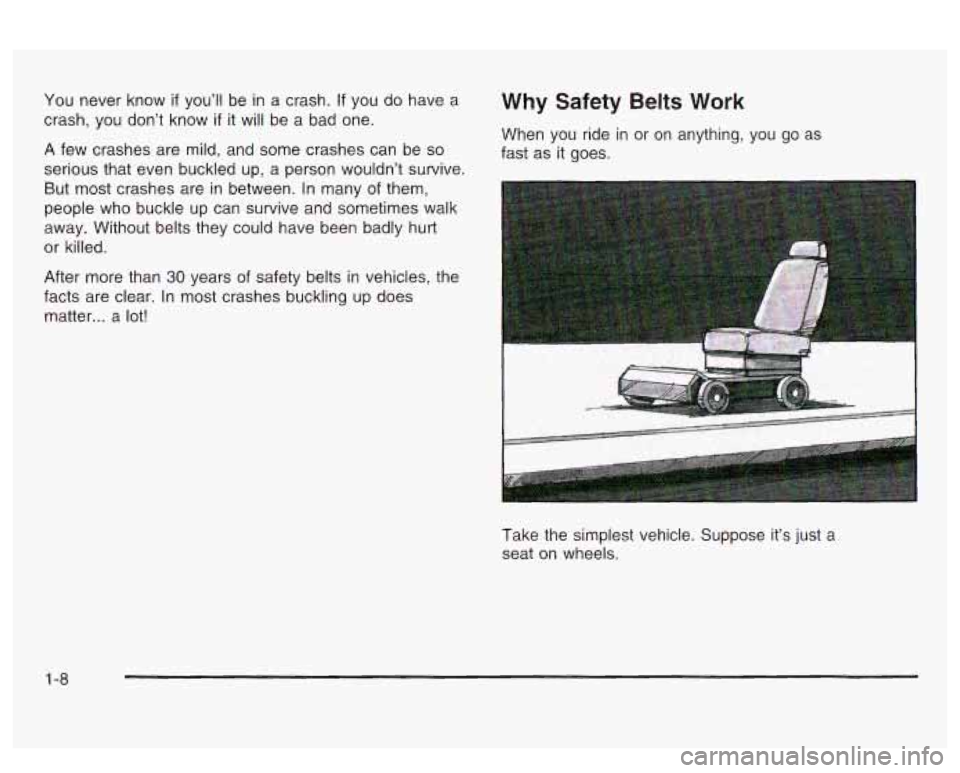
You never know if you’ll be in a crash. If you do have a
crash, you don’t know
if it will be a bad one.
A few crashes are mild, and some crashes can be so
serious that even buckled up, a person wouldn’t survive.
But most crashes are in between.
In many of them,
people who buckle up can survive and sometimes walk
away. Without belts they could have been badly hurt
or killed.
After more than
30 years of safety belts in vehicles, the
facts are clear. In most crashes buckling up does
matter
... a lot!
Why Safety Belts Work
When you ride in or on anything, you go as
fast as it goes.
Take the simplest vehicle. Suppose it’s just a
seat on wheels.
1-8
Page 16 of 418
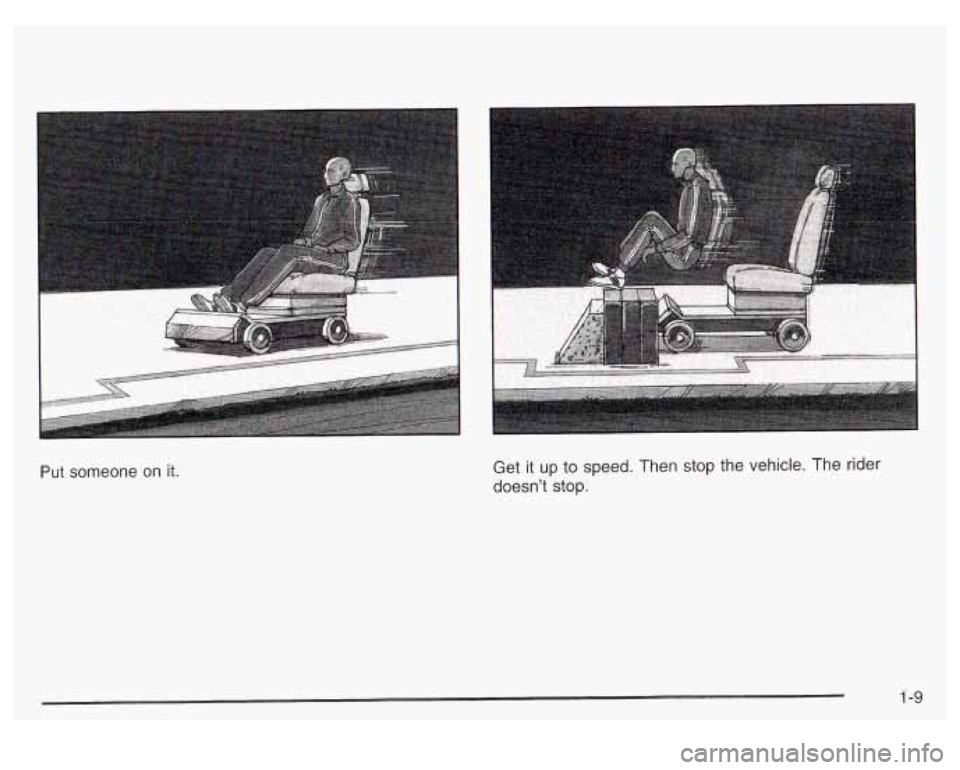
6- 1
uo auoaLUos lnd
Page 17 of 418

The person keeps going until stopped by something.
In a real vehicle, it could be the windshield
...
L
or the instrument panel ...
1-10
Page 18 of 418
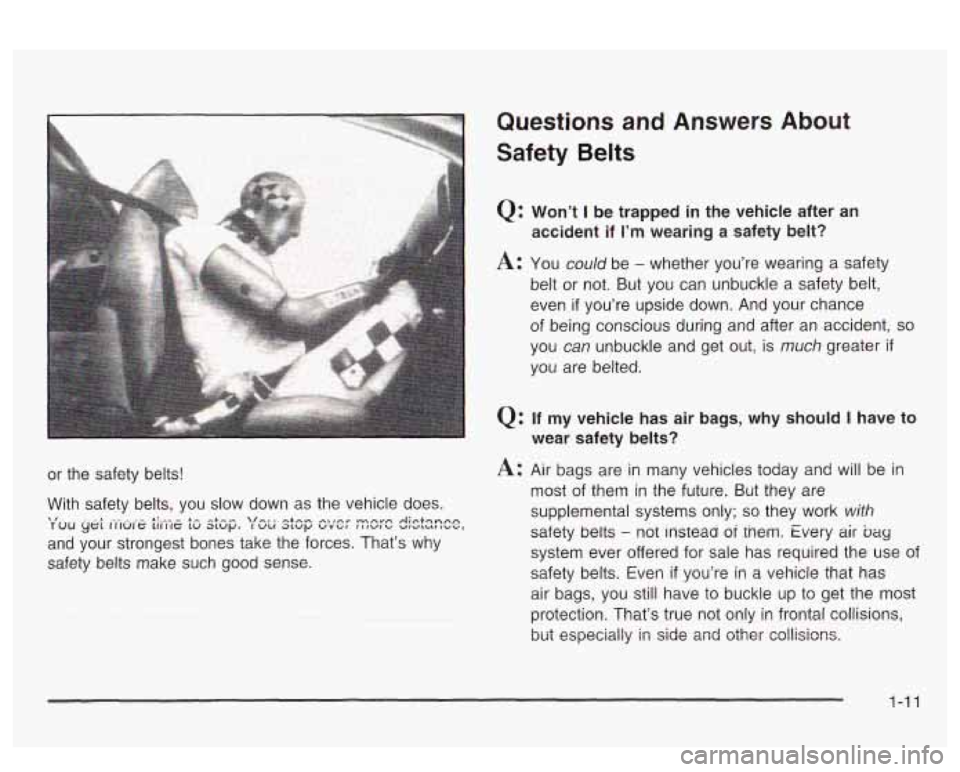
Questions and Answers About
Safety Belts
Q: Won’t I be trapped in the vehicle after an
accident
if I’m wearing a safety belt?
A: You could be - whether you’re wearing a safety
belt or not. But you can unbuckle a safety belt,
even
if you’re upside down. And your chance
of being conscious during and after an accident,
so
you can unbuckle and get out, is much greater if
you are belted.
Q: If my vehicle has air bags, why should I have to
wear safety belts?
or the safety belts!
With safety belts, you slow down as the vehicle does.
and your strongest bones take the forces. That’s why
safety belts make such good sense.
\I YOU yet r-nure the t~, SGP. ‘/X S:S~ CSY Z:CX dlsta~e,
A: Air bags are in many vehicles today and will be in
most
of them in the future. But they are
supplemental systems only;
so they work with
safety belts
- not lnsteaci oi tnem. Every air bag
system ever offered for sale has required the use of
safety belts. Even
if you’re in a vehicle that has
air bags, you still have to buckle up to get the most
protection. That’s true not only in frontal collisions,
sui especially in side and other collisions.
1-1 1
Page 19 of 418

Q: If I’m a good driver, and I never drive far from
At You may be an excellent driver, but if you’re in an
accident
- even one that isn’t your fault - you and
your passengers can be hurt. Being a good
driver doesn’t protect you from things beyond your
control, such as bad drivers.
Most accidents occur within
25 miles (40 km) of
home. And the greatest number of serious injuries
and deaths occur at speeds of less than
40 mph (65 km/h).
Safety belts are for everyone.
home, why should I wear safety belts?
How to Wear Safety Belts Properly
This part is only for people of adult size.
Be aware that there are special things to know about
safety belts and children. And there are different
rules for smaller children and babies.
If a child will be
riding in your vehicle, see
Older Children on page 7-27
or lnfants and Young Children on page 1-29. Follow
those rules for everyone’s protection.
First, you’ll want to know which restraint systems your
vehicle has.
We’ll start with the driver position.
Driver Position
This part describes the driver’s restraint system.
Lap-Shoulder Belt
The driver has a lap-shoulder belt. Here’s how to wear it
properly.
1. Close and lock the door.
2. Adjust the seat so you can sit up straight. To see
how, see “Seats’’ in the Index.
1-12
Page 20 of 418
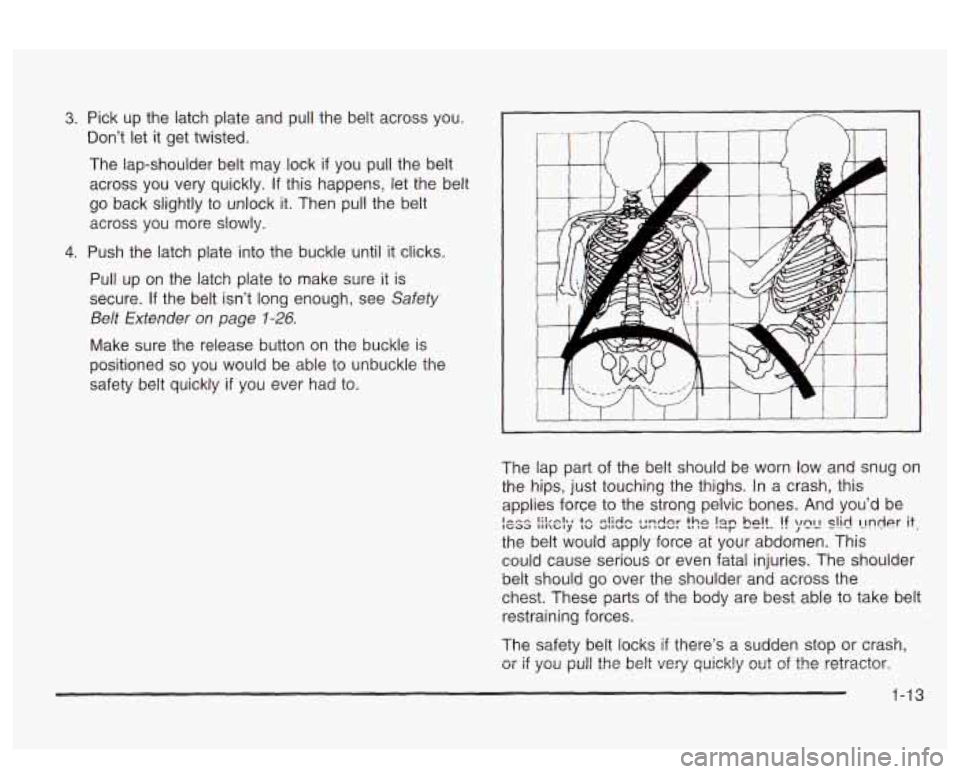
3. Pick up the latch plate and pull the belt across you.
Don’t let it get twisted.
The lap-shoulder belt may lock if
you pull the belt
across you very quickly.
If this happens, let the belt
go back slightly to unlock it. Then pull the belt
across
you more slowly.
4. Push the latch plate into the buckle until it clicks.
Pull up on the latch plate
to make sure it is
secure.
If the belt isn’t long enough, see Safety
Belt Extender on page 1-26.
Make sure the release button on the buckle is
positioned
so you would be able to unbuckle the
safety belt quickly
if you ever had to.
The lap part of the belt should be worn low and
snug on
the hips, just touching the thighs. In a crash, this
applies force to the strong pelvic bones. And you’d be
the belt would apply force at your abdomen. This
could cause serious or even fatal injuries. The shoulder
belt should go over the shoulder and across the
chest. These parts of the body are best able
to take belt
restratnmgforces.---
~~~~~ ~~~ ~ ~ ~~ ~~.
The safety belt locks if there’s a sudden stop or crash,
or
if you pull the belt very quickly out of the retractor.
I--- IGa3 ~;L,.I~~ IlRCFly +n Iw al1UQ nlidn u&luvk 1 lndor tho LI IV Ian sur hnlt wwa.. !f yc~ slid L!nr&r it,
..
1-13